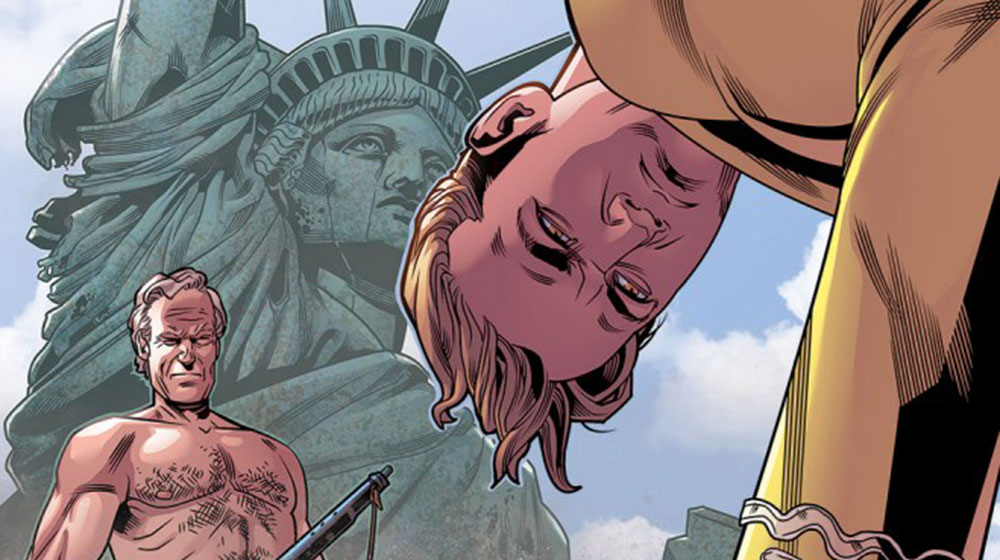Table of Contents Show
In 2015, two of the most recognizable film franchises from the late 1960s crossed over with one another from screen to page in the comic series Star Trek/Planet of the Apes: The Primate Directive. Starfleet Captain of the starship, USS Enterprise, Captain James. T. Kirk and former American astronaut space expedition leader George Taylor participate in hilarious dialogue, spats, and of course, some hand-to-hand fistfights during the ambitious miniseries. Colliding characters from multidimensional universes ignite disputes about upholding the Prime Directive and creates tensions between the humans, apes, and Klingons.
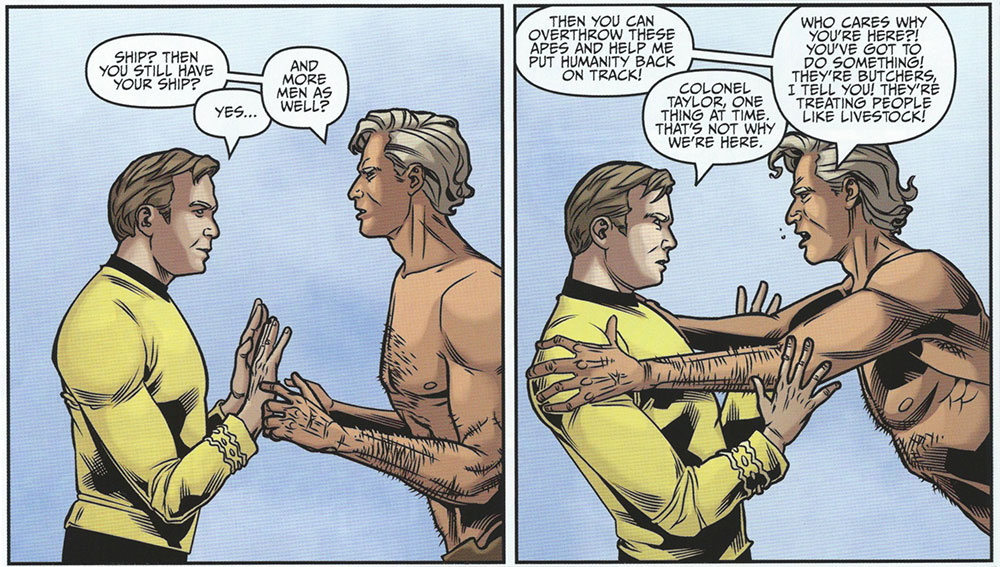
Star Trek/Planet of the Apes: The Primate Directive was written by the fraternal writing duo Scott and David Tipton. Illustrator Rachel Stott and colorist Charlie Kirchoff provided the gorgeous, hyper-realistic art of our favorite 60s sci-fi characters. Rounding out the comics’ creative team is masterful letterer Tom B. Long. IDW Publishing, holding ownership over the Star Trek expansive comics, and BOOM! Studios, owning the comic license for Planet of the Apes, formed a collaborative partnership to bring this comic series to life.
What Is The Prime Directive?
As a precursor to reading this comic, audiences should understand the concept of the ‘Prime Directive.’ The Prime Directive is a canonical ‘law’ merely implied or paraphrased during the course of the original Star Trek run. In Star Trek: The Original Series, ‘Starfleet General Order 1’ or the ‘non-interference directive’ was introduced in Season One, Episode Twenty-One, “The Return of the Archons.” During the episode, Captain Kirk suggested the imminent destruction of a computer, since it wielded unfettered control over a planetary civilization. Kirk and Science Officer Spock argued over the sentience of the computers as lawgivers. Then, Spock and Kirk first mention the Prime Directive onscreen:
“Captain, our Prime Directive of non-interference . . . That refers to a living, growing culture… do you think this one is?”
(( Star Trek: The Original Series. Season 1, Episode 21: “The Return of the Archons.” 1966-1969. NBC ))
Despite several entries in the Star Trek series detailing allusions to the Prime Directive, none have ever fully defined its meaning. The simplest definition emanates from non-canonical works, such as Michael and Denise Okuda’s book, “The Star Trek Encyclopedia” (1999). In this encyclopedia, the Prime Directive was described in layman’s terms as:
“The Prime Directive prohibits Starfleet personnel and spacecraft from interfering in the normal development of any society, and mandates that any Starfleet vessel or crew member is expendable to prevent violation of this rule.”
Michael and Denise Okuda (( Wikipedia contributors. “Prime Directive.” Wikipedia, The Free Encyclopedia. Wikipedia, The Free Encyclopedia, 9 May. 2021. Web. 28 May. 2021. ))
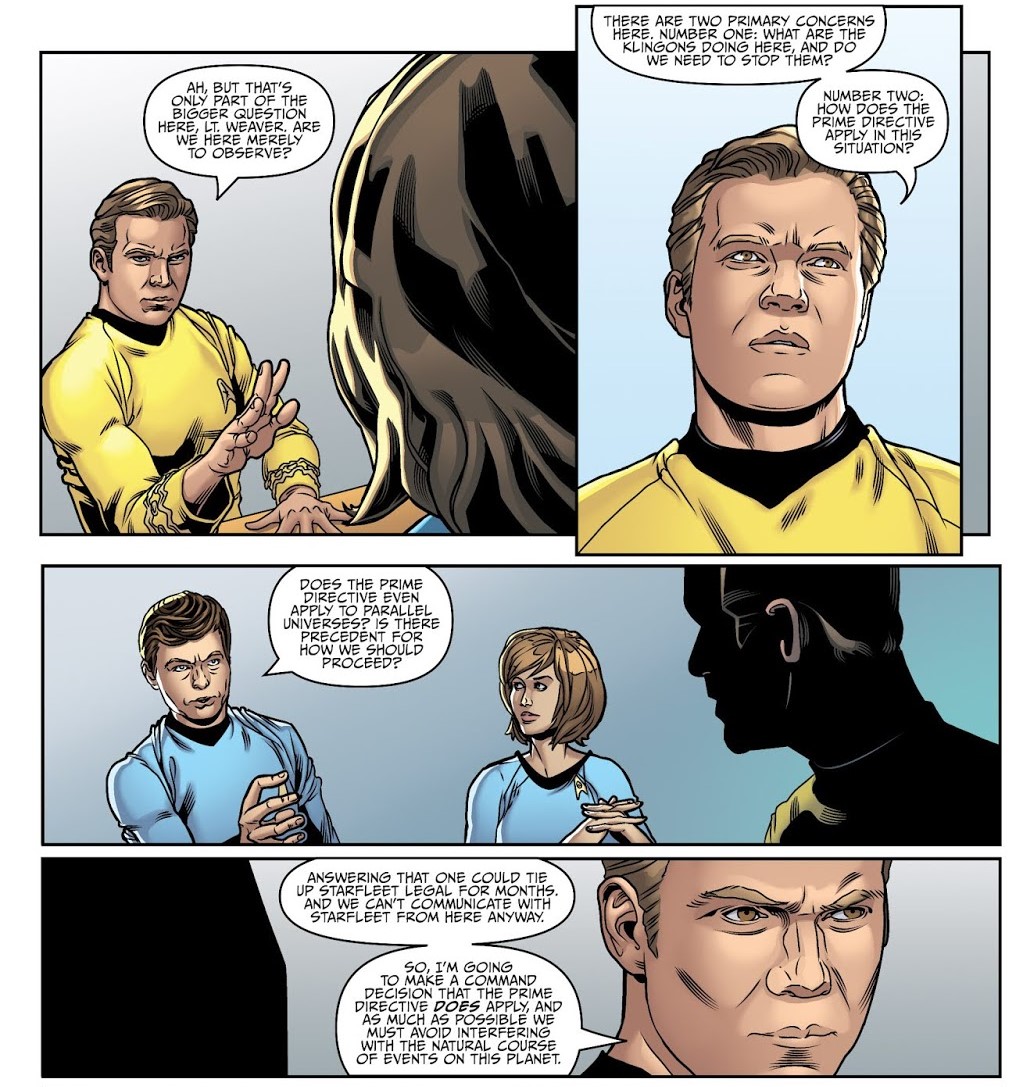
Another non-canonical interpretation of the directive adds: “Such interference includes introducing superior knowledge, strength, or technology to a world whose society is incapable of handling such advantages wisely. Starfleet personnel may not violate this Prime Directive, even to save their lives and/or their ship, unless they act to right an earlier violation or accidental contamination of said culture. This directive . . . carries with it the highest moral obligation.” (( Wikipedia contributors. “Prime Directive.” Wikipedia, The Free Encyclopedia. Wikipedia, The Free Encyclopedia, 9 May. 2021. Web. 28 May. 2021. )). Fans and analysts have criticized the concept of the Prime Directive. Not only is this ‘law’ converted into more of a social set of protocols for Starfleet members to follow at will, but many canonical episodes in several Star Trek iterations show the crew members interfering with other civilizations — or even colonizing whole planets.
Legalistically, the Prime Directive could never be enforced as an interstellar law to be upheld. Star Trek/Planet of the Apes investigates the idea further in their comic series. The plot focuses on the directive’s moral implications. Appropriately, wordplay transmutes the phrase ‘Prime Directive’ into ‘Primate Directive’ in conjunction with the Apes crossover narrative. The miniseries parses the law through the lens of questioning whether to interfere with the Klingons as they join forces with the primate-populated planet from the Planet of the Apes film series.
An Intergalactic Battle For The Planet Of The Apes
Star Trek/Planet of the Apes: The Primate Directive opens with a mysterious arms deal between a Klingon and a primate before cutting to some familiar Star Trek faces. On a mission to infiltrate a Klingon communications outpost, Officer Sulu and Lieutenant Uhura of the USS Enterprise discover that the Klingon Empire has been formulating plans for conquest. These notions come in direct conflict with the forced Organian Peace Treaty recently brokered between the Klingon Empire and the Federation of Planets. Sulu and Uhura successfully extract Klingon communications data, allowing Spock to decipher that the Klingons have begun territorial expansionist plans in another universe. Accordingly, Captain James Kirk, Spock, and his crew aboard the starship Enterprise use advanced drones to pass through the dimensional gateway portal the Klingons have been successfully traveling through.
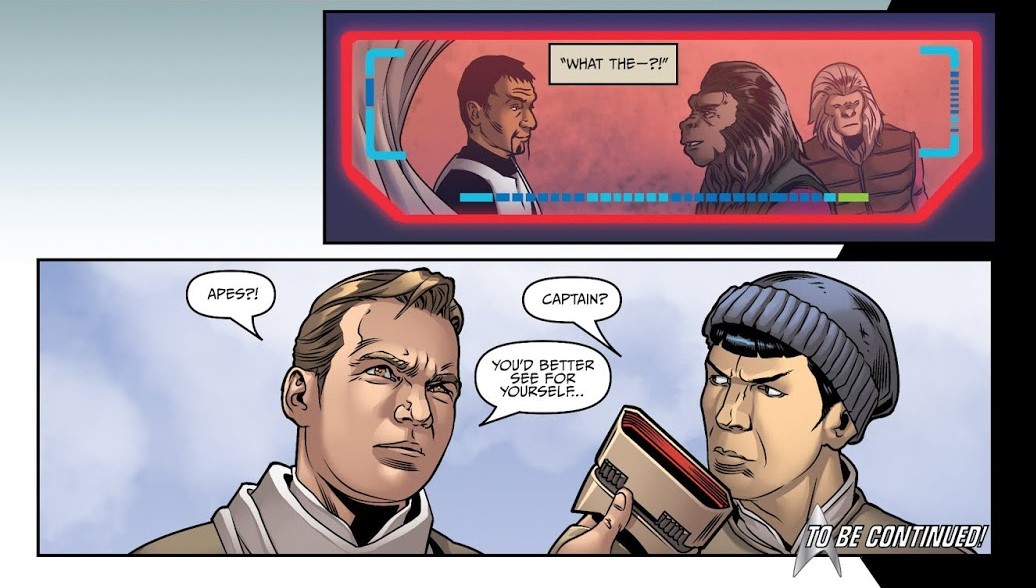
Transported into the future of an alternate universe in the year 3978, Kirk and Spock decide to investigate the near-identical Earth ravaged by nuclear war. The duo beam down to the foliage-laden planet. There, they find their old Klingon foe Kor spearheading the Klingon conquest initiative. Looking closer into their binoculars, the two observe primitive dwellings in this pre-industrialist society. It is then that Kirk and Spock unearth the identity of the individuals being provided firearms, aid, and unknowingly are submitting to eventual colonization by the Klingon Empire: Humanoid, bipedal, talking apes!
Meeting Taylor And The Applicability Of The Prime Directive
The bulk of Star Trek/Planet of the Apes occurs just subsequently to the concluding events in the original Planet of the Apes (1968) film. Second in command, Ape City gorilla, General Marius, becomes easily influenced by Kor’s encouragement to overthrow the leaders of the ape society — including famed orangutan leader, Dr. Zaius. Thus, for the Enterprise crew, the question of the aforementioned Prime Directive comes into play: Does the non-interference Prime Directive apply in a parallel universe? This comic ventures to answer that reoccurring inquest. According to Captain Kirk, breaching the Prime Directive remains inconceivable. The crew must also consider the culturally metastasizing implications already placed into effect by the Klingons’ sway on the primates. Ultimately, Kirk agrees wholeheartedly to stop the threat of Klingon conquest, by attempting to minimally influence the societal development of Ape City and its inhabitants.
Their mission faces further impediments when stranded astronaut Colonel George Taylor crosses paths with the Starfleet officers. Taylor’s desperation to correct the ape-dominant, human-inferior culture Earth has transformed into manifests itself through sheer anger at Kirk’s morals. Specifically, he finds Kirk’s stalwartness in maintaining the Prime Directive on a planet mirroring Earth incredibly frustrating. Taylor cannot see this future Earth in his universe as an “alien” planet. Still, Kirk is not inclined to agree with the maniacal Taylor.
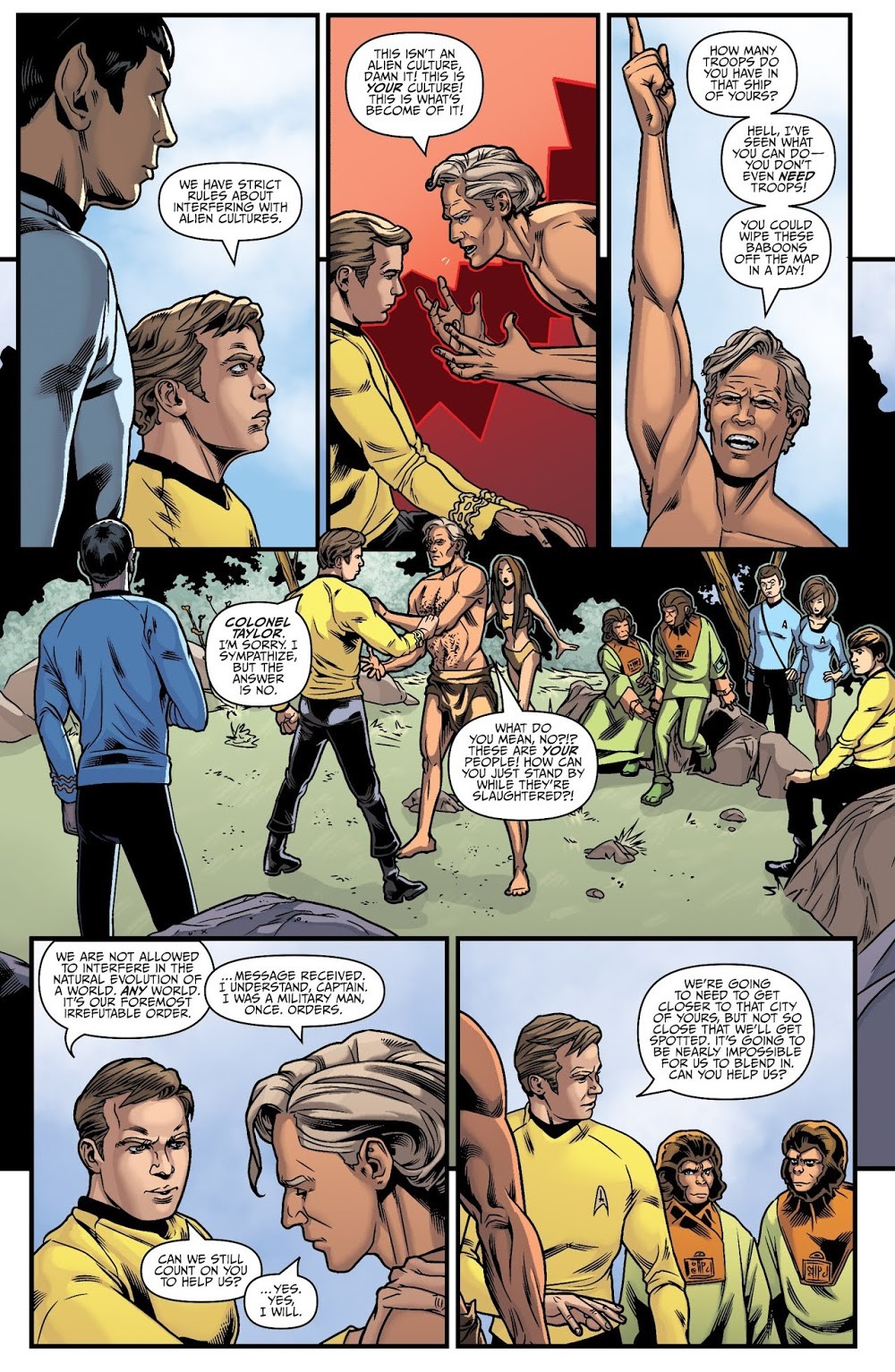
Eventually, Kirk, Spock, Chekov, McCoy, and Lt. Weaver join forces with the pragmatic, science-oriented chimpanzees from Ape City, couple Zira and Cornelius. The chimpanzees discuss the recent uprising in gorilla militarism behaviors and break down the class system organization of their stratified society, keeping with the cinematic Apes canon. But neither Zira, Cornelius, or Captain Kirk are able to douse the flames of Taylor’s unhinged desire for vengeance on the apes. A non-complacent Taylor takes action, beaming aboard the Enterprise. Meanwhile, in Ape City, Dr. Zaius is acquiescing to the Klingon’s infiltration amidst the prospect of imminent famine. With his successful orchestration thus far, Kor hopes his puppeteering of General Marius will compel Marius to assassinate the prominent gorilla leader, General Ursus. The primary goals of the Star Trek crew in Star Trek/Planet of the Apes then include rationalizing morals with vengeance-obsessed Taylor, stopping the Klingons from deconstructing and colonizing Ape City, and, most importantly, following the Prime Directive.
An Ideal Fan-Servicing Narrative With Canonical Integrity
Star Trek/Planet of the Apes: The Primate Directive functions as a worthy adaption of its eponymous on-screen franchises. Additionally, the comic wonderfully bridges narrative gaps between the second and third Planet of the Apes films during the fifth and final issue. The comic combines the two science-fiction franchises coherently. Reading the comic series feels like watching a missing Star Trek: TOS episode or an extended version of the Planet of the Apes film. Scott and David Tipton also service the narrative constructively by integrating the identifiable characterizations of the characters famously seen in their on-screen counterparts.
Captain Kirk takes his leadership responsibilities seriously in the comic, leaning on Spock’s superior intellect for analytical deductions when Kirk’s own conclusions feel inadequate. Readers witness George Taylor in an elevated sense of distress as Kirk continually dashes Taylor’s hopes of reclaiming Earth from the apes. Deuteragonists also remain loyal to their cinematic behaviors. Zira and Cornelius engage in plausible intelligent conversations to reiterate the rules within their class system society. Humorously, moments of levity are extended in the narrative to capture Zira and Cornelius’s traits of caring deeply about one another. Additionally, Enterprise crewmates Chekov, McCoy, Uhura, and Sulu exhibit behavior and speech patterns, organically meshing with their television show personalities.
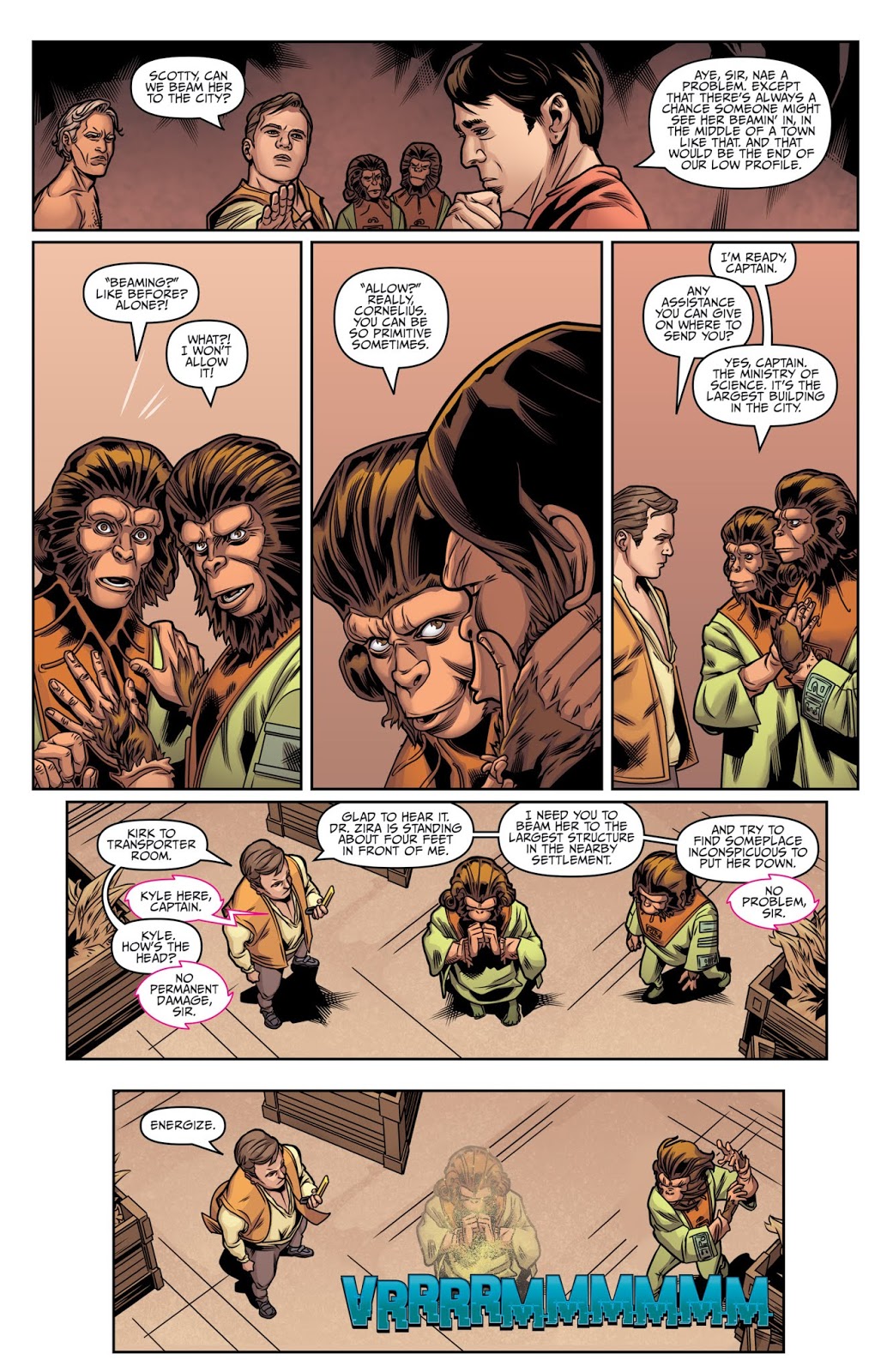
It would be remiss not to mention the fan-servicing elements present in this comic series. The Tipton brothers manage to give fans of the franchises what they crave in this comic series while weaving these popular moments congruously into the narrative. Unsurprisingly, Taylor utters his renowned phrases from Planet of the Apes. One such famous quote occurs in the scene where Taylor fights Kirk and deems Earth a “madhouse.” Taylor also impersonates Captain Kirk when he steals Chekov’s communicators and requests the Enterprise transporter “beam [him] aboard.” Characters such as Nova, General Ursus, and even the Lawgiver are all cleverly interspersed throughout the narrative. Moments where Scotty describes the time-traveling “slingshot maneuver” to Cornelius and his notable vernacular or when Cornelius relates the resolute law that “ape shall not kill ape” showcases the Tipton’s commitment to the cinematic canon. The Tipton brothers’ comic script adaptation undoubtedly entertains franchise fans.
Narrative Similarity And Character Deviance In Star Trek/Planet Of The Apes
Scott and David Tipton’s Star Trek/Planet of the Apes comic distills lessons on morality, adapts the framework of the sci-fi genre well, and reconciles a major plot hole occurring between films Beneath the Planet of the Apes (1970) and Escape from the Planet of the Apes (1971). All the positive aspects existing in the series should galvanize the franchise fandoms into reading this comic series. Nevertheless, readers should recognize a few criticisms about the comics without allowing these critiques to overshadow overall enjoyment. Firstly, a main observation many readers and Star Trek: The Original Series fans notice in the Star Trek/Planet of the Apes comic adaptation is its narrative resemblance to an original television episode.
In Season Two, Episode Nineteen, “A Private Little War” of Star Trek: TOS, the USS Enterprise crew explores the primitive planet, Neural. There, Captain Kirk and Spock find the Klingons supplying the Neural villagers with firearms. The Klingons produce weapons for the villagers while probing the peaceful society to engage in an arms race with an opposing group called the Hill People. Star Trek/Planet of the Apes mirrors the episode closely, but not exactly. Enough parallels can be drawn when considering the integrity of the comics’ originality. In defense of this comic series, the narrative concentrates on the thought-provoking Prime Directive law over an arms race plot. Analysts have also discussed “A Private Little War” in terms of the plot acting as an allegory for the late 60s involvement of the U.S. in the Vietnam War.
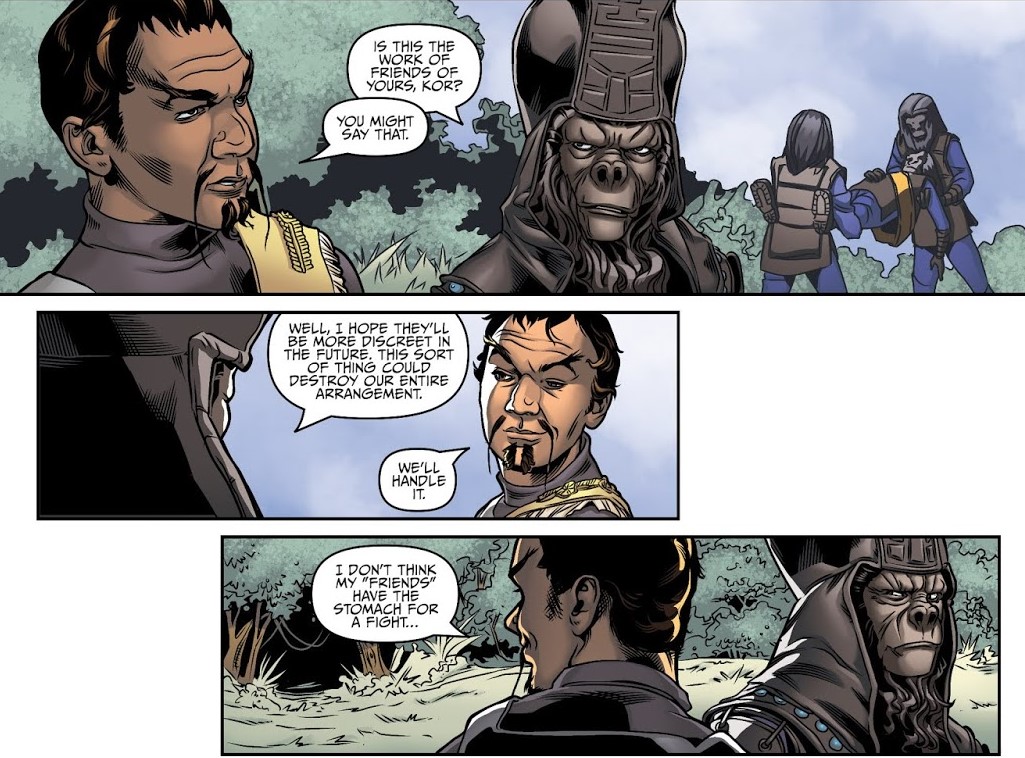
One other criticism over Star Trek/Planet of the Apes focuses on George Taylor’s character portrayal. Distinctively, Taylor appears more fanatical in the comic book than his representation in the film series. But if the first issue is set immediately following Planet of the Apes (1968), then Taylor’s interaction with other humans — humans who can not only speak but have weapons and a means to escape the planet of the apes — seems justifiable. Taylor spends the entirety of the first film trying to escape his captors. Discovering the Statue of Liberty enlightens Taylor to the fact that he was on a future version of his own Earth the whole time. This revelation drives him into unadulterated dismay at the film’s closing scene.
When Kirk, Spock, and the other officers encounter Taylor in the comic after this event, wouldn’t Taylor relish the opportunity to take Nova and the other mute humans away from the ape-run Earth humans cannot escape? Though Taylor’s characterization may seem extreme, parsing the comic events through the perspective of the Planet of the Apes film absolves much of this critique. The rationale behind Taylor’s final soliloquy in issue five also deserves a critical assessment. Without spoiling the ending, Taylor conclusively decides not to join Kirk’s crew aboard the Enterprise. Refusing Kirk’s offer is logical when considering that Taylor — and historically, the other inhabitants of planets the crew meets in the Star Trek show — cannot be taken from his universe/planet onto the starship. His declination makes sense canonically, but Taylor’s reasoning falls flat in terms of character motivation.

Taylor’s dialogue appears unconvincing in these final scenes. Then again, Captain Kirk would probably be violating ethics superseding the Prime Directive by pulling Taylor out of a parallel universe. Kirk’s invitation itself feels uncharacteristic after a whole five issues debating the moral consequences of breaching the Prime Directive. In the end, the two independent men going their separate ways proves for the best. Kirk doesn’t need someone on board to brawl.
Artistic Freedom: Illustrative Benefits
People who have never seen an episode of Star Trek or watched the glory that is the Planet of the Apes movies have most likely retained knowledge around the characters/concepts through cultural osmosis. A previous comic book adaptation of the original Planet of the Apes film falls short due to a dispute over rendering Charlton Heston’s image. Fortunately for Star Trek/Planet of the Apes, IDW, and BOOM! obtained the proper license from the Heston estate to include Heston’s likeness as George Taylor in the comic series. The comic series owes much of its success to the familiar depictions of iconic characters drawn by the then-newcomer artist Rachel Stott. Rachel Stott made her debut as a comic book artist with this comic series.
With full rights over character illustrative portrayals, Stott enlivens the universes of both Star Trek and Planet of the Apes in every panel. Emotions of all varieties expressively grace the faces of titular characters James Kirk and George Taylor. Intense fight sequences occur in the familiar jungles by Ape City or aboard the expansive rooms in the Enterprise. Zira, Cornelius, and Dr. Zaius are represented with their colorful fur and human-esque qualities. Stott illustrates the apes’ appearance as to mirror their Planet of the Apes film counterparts. Associative colors for the Starfleet officers or the differing ape families link the famous characters further with their identities.
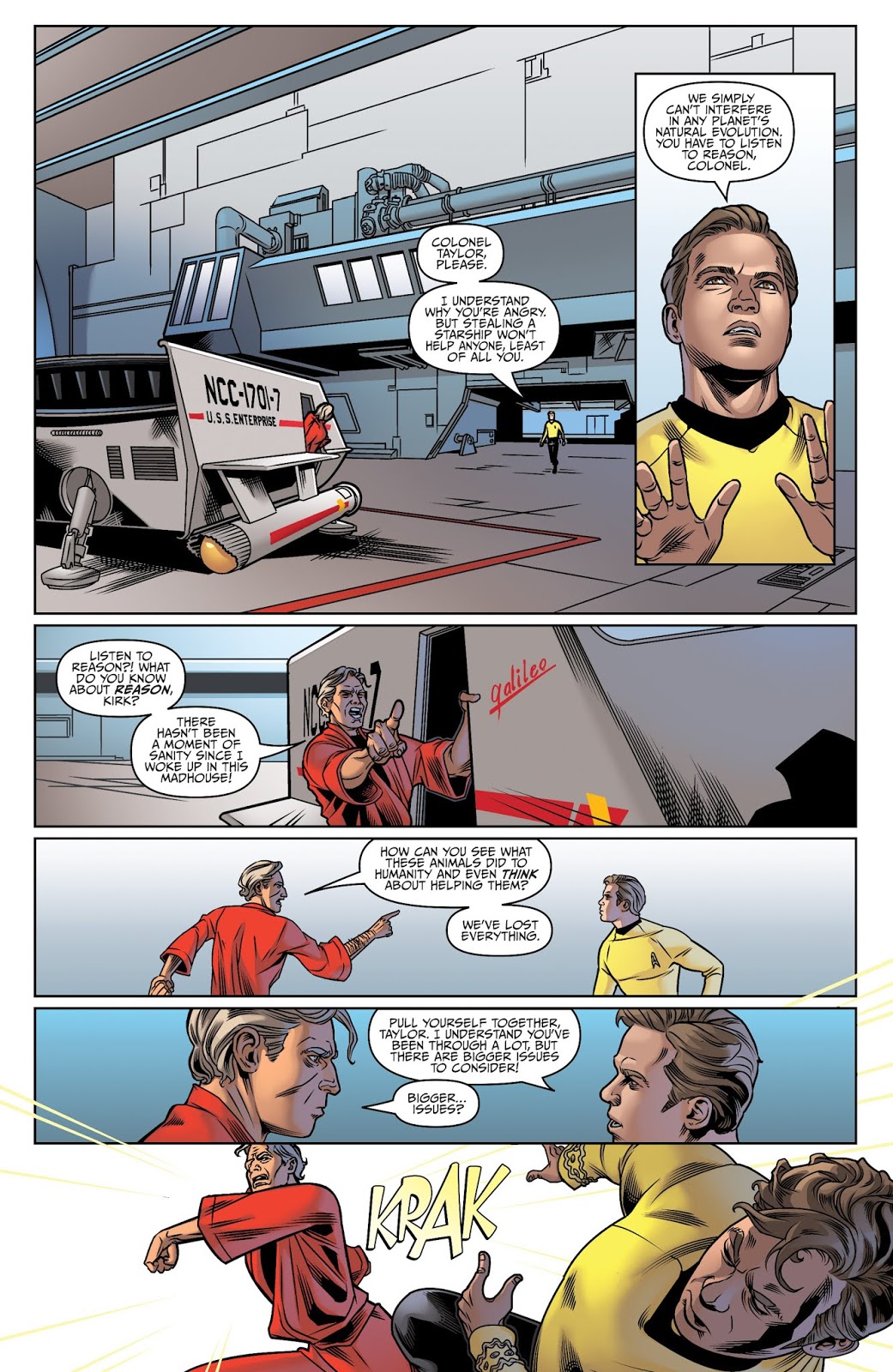
Because conversations frequently occur around the Prime Directive’s moral repercussions, the characters display mercurial temperaments. Stott’s illustrations shepherd a scintillating visual representation of the emotional tension playing out in the dialogue. Photorealistic renderings of Kirk and Taylor fighting one another in heated standoffs of words — or fists — take on a rich cinematic style. Finally, supplementing these scenes are letterer Tom B. Long’s SFX work pounding, punching, and screaming from the page. Artistic freedom paid off in dividends for Rachel Stott. Her talent brings these characters — their expressionism, motivations, or ethical quandaries — to life in a manner that creates a sense of physically watching a lost crossover episode of Star Trek.
Star Trek/Planet Of The Apes: The Primate Directive: An Essential Comic
Crossovers in any medium possess the potential to succeed or to come across as boringly contrived. Star Trek/Planet of the Apes: The Primate Directive pays homage to the canons of its predecessor media properties while imagining a delightful take of its own on the franchises. Knowledge of at least one — ideally both — of these properties prior to reading presents the only major dissuasion for potential readers of this comic series. Nonetheless, the story and art hold up on their own. As opposed to mashing up two sci-fi stories incoherently, the comic miniseries investigates complex themes like morality, colonization, and humanity in the backdrop of the legally questionable Prime Directive law. Star Trek/Planet of the Apes: The Primate Directive is an essential read for fans of either series.
